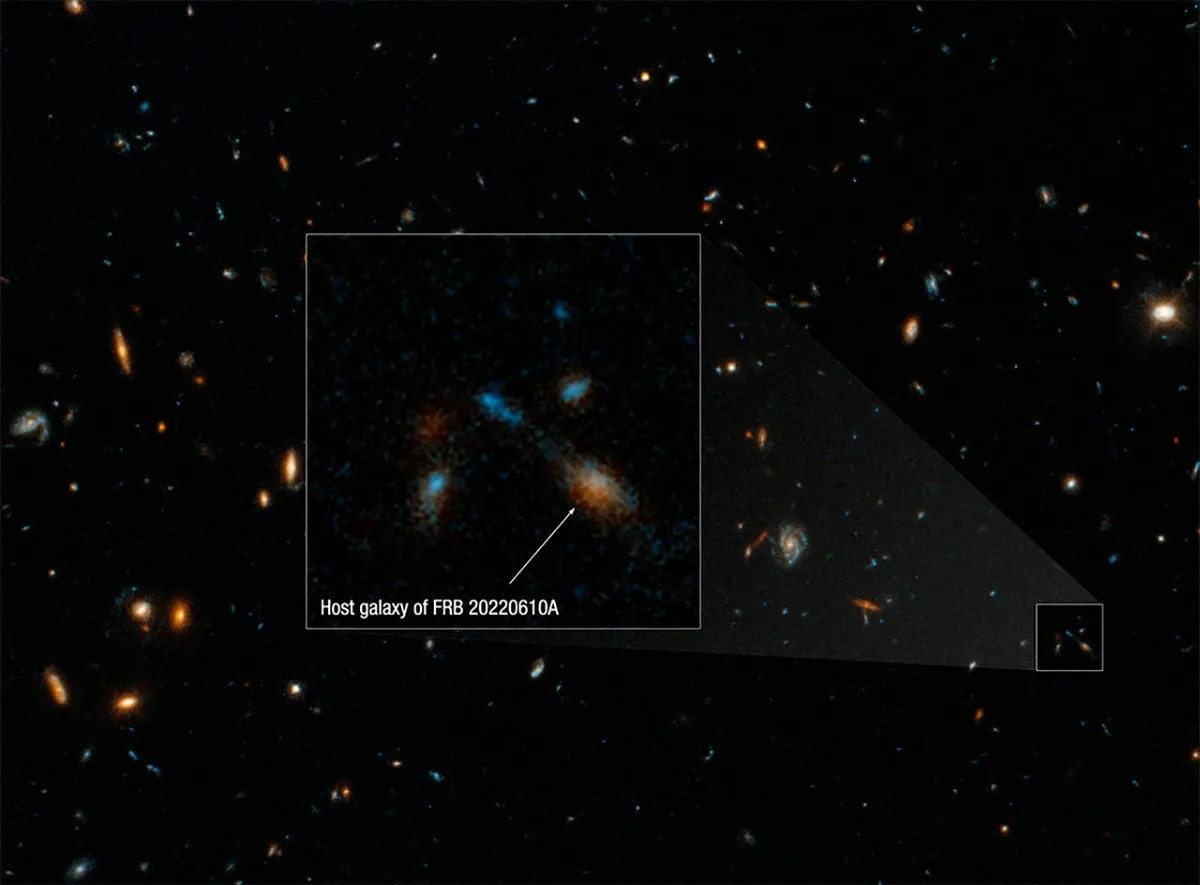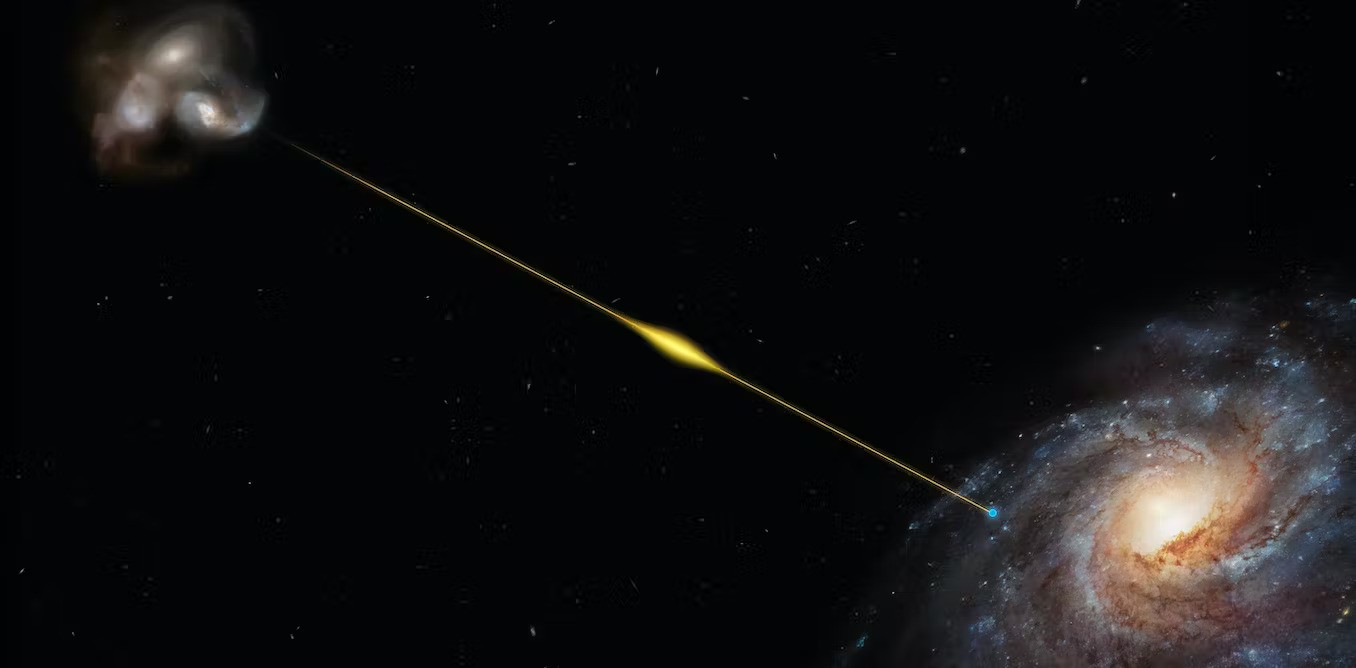7 Interacting Galaxies Identified As Source Of Mysterious Radio Signal
7 interacting galaxies identified as source of mysterious radio signal, as astronomers pinpoint it to an unusual cosmic location: a rare assemblage of "blob-like" galaxies. This unexpected revelation may provide valuable insights into the enigmatic nature of these brief and intense bursts of radio waves that have perplexed scientists for years.
Author:Paula M. GrahamReviewer:Hajra ShannonJan 12, 20245.9K Shares164.8K Views

7 interacting galaxies identified as source of mysterious radio signal, as astronomers pinpoint it to an unusual cosmic location: a rare assemblage of "blob-like" galaxies. This unexpected revelation may provide valuable insights into the enigmatic nature of these brief and intense bursts of radio waves that have perplexed scientists for years.
The powerful signal, designated as FRB 20220610A, was first observed on June 10, 2022, and it traversed a staggering distance of 8 billion light-years to reach Earth. To put this in perspective, a light-year is the distance light travels in one year, equivalent to about 5.88 trillion miles (9.46 trillion kilometers).
Fast radio bursts (FRBs) are brief bursts of radio waves lasting milliseconds with elusive origins. The initial discovery of an FRB dates back to 2007. Since then, researchers have detected hundreds of these rapid and intense cosmic flashes emanating from various distant points in the universe.
The specific FRB in question endured for less than a millisecond but exhibited an energy level four times higher than previously recorded FRBs. According to an initial study published in October, this burst unleashed an amount of energy equivalent to the sun's emissions over 30 years.
FRBs, characterized by their brief and intense bursts of super bright radio waves lasting only a few milliseconds, pose a challenge for observation due to their fleeting nature. To overcome this obstacle, researchers have relied on radio telescopes, employing tools such as the Australian Square Kilometre Array Pathfinder (ASKAP) in Western Australia and the Very Large Telescope of the European Southern Observatory in Chile to track the paths of these rapid cosmic flashes and pinpoint their origin.
Initial observations suggested a celestial anomaly, initially considered to be either a single irregular galaxy or a trio of interacting galaxies. However, recent insights, utilizing images from the Hubble Space Telescope, have unveiled that the source of the fast radio burst is a conglomerate of at least seven galaxies.
Remarkably, these galaxies are so closely packed that they could all comfortably fit within the confines of our own Milky Way galaxy. These significant findings were presented at the 243rd meeting of the American Astronomical Society in New Orleans.
An Unusual Galactic Group
The galaxies within the identified group appear to be engaged in interactions, possibly even undergoing a merger. According to the researchers, this dynamic interaction between the galaxies could be what causes the fast radio burst.
"Without the Hubble's imaging, it would still remain a mystery as to whether this FRB originated from one monolithic galaxy or from some type of interacting system," said lead study author Alexa Gordon, a doctoral student in astronomy at Northwestern University’s Weinberg College of Arts and Sciences, in a statement.
“„It's these types of environments - these weird ones - that drive us toward a better understanding of the mystery of FRBs.- Alexa Gordon
Described as a compact group, the galactic assembly stands out as an extraordinary illustration of the "densest galaxy-scale structures we know of," according to study coauthor Wen-fai Fong, an associate professor of physics and astronomy at Northwestern and Gordon's adviser.
According to Gordon, the ongoing interactions between the galaxies in this compact group could potentially trigger bursts of star formation, offering a plausible explanation for the observed fast radio burst.
While fast radio bursts have predominantly been associated with isolated galaxies, astronomers have also identified them in globular clusters, and now, in the case of this discovery, within a compact group, according to Gordon.
"We just need to keep finding more of these FRBs, both nearby and far away, and in all these different types of environments," she said.
The Origins Of Fast Radio Bursts
Since their first identification nearly two decades ago, almost 1,000 fast radio bursts have been observed, yet astronomers continue to grapple with the elusive origins of these phenomena. While the precise cause remains uncertain, there is consensus among many researchers that compact objects, such as black holes or neutron stars (the dense remnants of exploded stars), likely play a role.
Recent studies also propose that magnetars, highly magnetized stars, might be the primary source of fast radio bursts. Unraveling the origin of fast radio bursts is crucial for astronomers as it could provide valuable insights into the fundamental mechanisms propelling these bursts across the universe.
"Despite hundreds of FRB events discovered to date, only a fraction of those have been pinpointed to their host galaxies," said study coauthor Yuxin Vic Dong in a statement. "Within that small fraction, only a few came from a dense galactic environment, but none have ever been seen in such a compact group. So, its birthplace is truly rare." Dong is a National Science Foundation graduate research fellow and doctoral student of astronomy in Fong’s lab at Northwestern.
Gaining further insights into fast radio bursts could potentially unveil revelations about the fundamental nature of the universe. As these bursts traverse space over billions of years, their interactions with cosmic material offer a unique opportunity to study the cosmic landscape and deepen our understanding of its intricacies.
“„Radio waves, in particular, are sensitive to any intervening material along the line of sight - from the FRB location to us. That means the waves have to travel through any cloud of material around the FRB site, through its host galaxy, across the universe, and finally through the Milky Way. From a time delay in the FRB signal itself, we can measure the sum of all of these contributions.- Wen-fai Fong
Astronomers are eagerly anticipating the development of more sensitive methods for detecting fast radio bursts in the future. Gordon noted that these developments have the potential to uncover more of these phenomena, even at greater distances.
"We are ultimately trying to answer the questions: What causes them? What are their progenitors and what are their origins? The Hubble observations provide a spectacular view of the surprising types of environments that give rise to these mysterious events," Fong said.

Paula M. Graham
Author

Hajra Shannon
Reviewer
Latest Articles
Popular Articles
